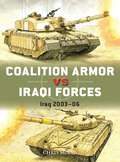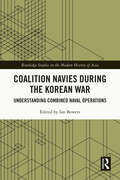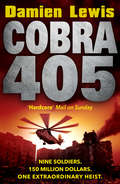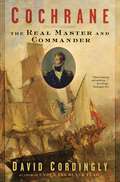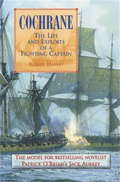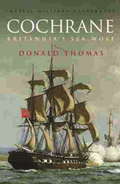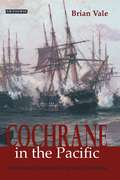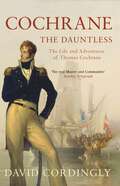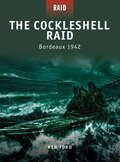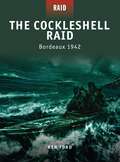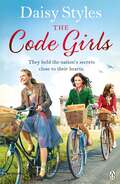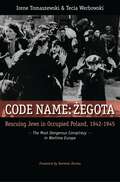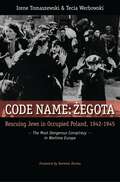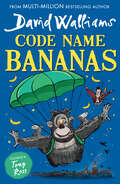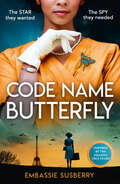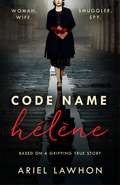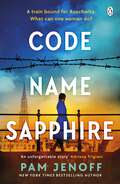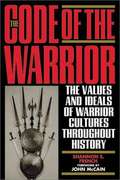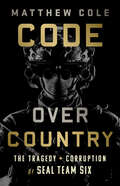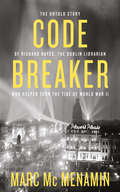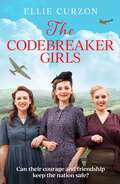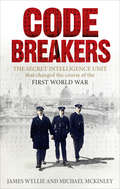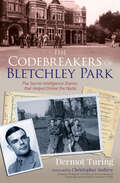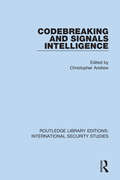- Table View
- List View
Coalition Armor vs Iraqi Forces: Iraq 2003–06 (Duel #133)
by Chris McNabAn illustrated study of how coalition armor in Iraq in 2003–06 handled a unique multi-threat environment, from enemy armor to IEDs.On 20 March 2003, Coalition forces launched the invasion of Iraq on a massive scale. Their armored fighting vehicles (AFVs) faced an uncertain level of resistance, and soon had to overcome a wide range of enemy threats. These included tank vs tank clashes during the first days of the invasion (most famously at Basra and Mahmoudiyah), and subsequently the dangers posed by enemy rocket-propelled grenades, cannon fire, antitank guided missiles, and improvised explosive devices.This vital new study covers both the opening clashes between opposing AVFs and the tactics developed by Iraqi insurgents seeking to neutralize Coalition superiority. Featuring full color photos, battle scenes, weaponry, and tactical illustrations, it draws upon first-hand accounts and official post-battle analyses to examine how Coalition forces responded to the change in the nature of the threats. Among the topics addressed are the coordination between Coalition infantry and air power; how dealing with roadside bombs in Iraq resulted in changes to equipment, tactics, and force structure; and the lessons learned for future warfare.
Coalition Navies during the Korean War: Understanding Combined Naval Operations (Routledge Studies in the Modern History of Asia)
by Ian BowersThis book presents a detailed assessment of the role of navies in the Korean War. It highlights that, despite being predominantly a land war, navies played a vital part. Moreover, the naval war was not solely a U.S. operation. Smaller navies from many countries made important contributions both in supporting the United States and carrying out independent and combined naval operations. This subject holds special importance since current Western strategic thinking and capabilities emphasise the necessity of combined naval operations involving multiple navies in any potential future naval conflict. The example set by the Korean War therefore offers valuable insights into the operational and strategic problems, and benefits and opportunities of contemporary and future combined coalition naval operations.
Coalition Navies during the Korean War: Understanding Combined Naval Operations (Routledge Studies in the Modern History of Asia)
This book presents a detailed assessment of the role of navies in the Korean War. It highlights that, despite being predominantly a land war, navies played a vital part. Moreover, the naval war was not solely a U.S. operation. Smaller navies from many countries made important contributions both in supporting the United States and carrying out independent and combined naval operations. This subject holds special importance since current Western strategic thinking and capabilities emphasise the necessity of combined naval operations involving multiple navies in any potential future naval conflict. The example set by the Korean War therefore offers valuable insights into the operational and strategic problems, and benefits and opportunities of contemporary and future combined coalition naval operations.
Cobra 405
by Damien Lewis1976, war-torn Beirut. An unknown band of armed men blast their way into the Imperial Bank of Beirut. Over the next 48 hours they load up three trucks with gold bullion, and the raiders and the loot disappear forever. But whilst the heist went like clockwork, they are forced to hide the loot and make their getaway. Thirty years later, they are planning their return. . . The only problem is that a powerful and ruthless enemy is hell bent on finding the gold before them. So begins a race against time to get to the gold before the deadly Black Assassins group can catch up with them.
Cochrane: The Real Master and Commander
by David CordinglyIn this fascinating account of Thomas Cochrane's extraordinary life, David Cordingly (Under the Black Flag and The Billy Ruffian) unearths startling new details about the real-life "Master and Commander"-from his heroic battles against the French navy to his role in the liberation of Chile, Peru, and Brazil, and the stock exchange scandal that forced him out of England and almost ended his naval career. Drawing on previously unpublished papers, his own travels, wide reading, and original research, Cordingly tells the rip-roaring story of the archetypal Romantic hero who conquered the seas and, in the process, defined his era.
Cochrane: The Life And Exploits Of A Fighting Captain
by Robert HarveyThe adventures of the daring Thomas Cochrane, called 'the sea wolf' by Napoleon, are so extraordinary that his life reads like a page-turning work of fiction. In one sense it became so, for the novelist Patrick O'Brian by his own admission used Cochrane as the basis for Jack Aubrey, hero of his much-loved series of naval novels.Cochrane became a household name when in 1800 he took command of the tiny brig, the Speedy, and created mayhem in the Mediterranean earning himself and his crew a fortune in prize money. A wildly contradictory character, never less than heroic, and this lively new account of his life has sold over 7,000 copies in hardback.
Cochrane: Britannia's Sea Wolf (Sven Hassel War Classics)
by Donald ThomasBestselling account of the life of a real Horatio HornblowerThe life of Thomas, Lord Cochrane, later 10th Earl of Dundonald, was more extraordinary than that of Nelson, more far fetched than that of Hornblower or Patrick O'Brien's Jack Aubrey. Born the son of an eccentric and indigent Scottish peer, he entered the Royal Navy in 1793. In a series of outstanding and heroic actions, often against seemingly overwhelming odds, he made his name fighting Napoleon's navy as one of the most dashing and daring frigate captains of his day, before embarking on a career as a mercenary admiral.
Cochrane in the Pacific: Fortune and Freedom in Spanish America
by Brian ValeIn 1818, the revolutionary government of Chile was poised to attack Peru, the last bastion of Spanish power on the continent. Until then, the liberation of South America had been dominated by the clash of armies, on land. But the need to move the army of General José de San Martin up the coast made it necessary to seize control of the Pacific. The new ruler of Chile, the half-Irish Bernardo O'Higgins, threw his energies into creating a navy. Short of local naval manpower, the Chileans looked to Britain and the United States for the sailors needed to man and command their squadrons, many of them unemployed veterans of the Royal Navy. As the new navy's commander-in-chief, they recruited one of the most fearless and controversial officers of the age: Thomas, Lord Cochrane. The war brought out the best and the worst in Lord Cochrane. Its huge panorama gave ample scope for his aggression, bravery and flare. But high command also produced tensions and problems that brought out the negative side of his suspicious and troubled personality.The story of the naval war in the Pacific is an exciting one. Under Cochrane's audacious leadership, coasts were blockaded, fortresses stormed and ships seized in bloody hand-to-hand fighting. The result was that Chile and Peru gained their freedom from Spain, while Cochrane enhanced his reputation and made a fortune in pay and prize money. For one hundred and fifty years, the accepted story of the war has been based on Cochrane's own version of events and the allegation that all these victories were achieved in the face of disloyalty, plots and treachery. How accurate is Cochrane's account? And what really happened in the war at sea? To answer these questions, Brian Vale goes back to the original documents, despatches, diaries and newspapers. The result is a new and vivid account of the war in the Pacific and a reassessment of one of Britain's legendary naval heroes seen at the peak of his career.
Cochrane the Dauntless: The Life and Adventures of Thomas Cochrane, 1775-1860
by David CordinglyPatrick O'Brian, C.S. Forester and Captain Marryat all based their literary heroes on Thomas Cochrane, but Cochrane's exploits were far more daring and exciting than those of his fictional counterparts. He was a man of action, whose bold and impulsive nature meant he was often his own worst enemy. Writing with gripping narrative skill and drawing on his own travels and original research, Cordingly tells the rip-roaring story of a flawed Romantic hero who helped define his age.
The Cockleshell Raid: Bordeaux 1942 (Raid #8)
by Ken FordOn the night of December 7, 1942, five canoes were launched off the mouth of the Gironde river, each containing a pair of British commandoes tasked with slipping into the port of Bordeaux and destroying as many of the merchant ships as possible. Only two of the canoes made it to the target, but it was enough. Five enemy ships were badly damaged in the attack. It then became a game of cat and mouse for the surviving commandoes in their attempt to get back to Britain. Some of the men made it to Gibraltar; others were caught and executed. Author Ken Ford gives a blow-by-blow account of one of the most daring raids of World War II, which badly upset the flow of material into Germany, and which gave the British public a much needed victory.
The Cockleshell Raid: Bordeaux 1942 (Raid)
by Howard Gerrard Ken Ford Mariusz KozikOn the night of December 7, 1942, five canoes were launched off the mouth of the Gironde river, each containing a pair of British commandoes tasked with slipping into the port of Bordeaux and destroying as many of the merchant ships as possible. Only two of the canoes made it to the target, but it was enough. Five enemy ships were badly damaged in the attack. It then became a game of cat and mouse for the surviving commandoes in their attempt to get back to Britain. Some of the men made it to Gibraltar; others were caught and executed. Author Ken Ford gives a blow-by-blow account of one of the most daring raids of World War II, which badly upset the flow of material into Germany, and which gave the British public a much needed victory.
The Code Girls
by Daisy Styles**A heart-warming and inspiring story of incredible women on the home-front during World War II from the author of The Bomb Girls**Can four girls protect a whole country? It's 1941 and the country has been turned upside down. For the aristocratic Walsingham family this means being pushed unceremoniously upstairs while their grand home is taken over by the Army. But for newcomers Ava and Maudie this is a chance to get something more from life. They are at Walsingham Hall to become code girls and break German encryptions.So being sent downstairs to work in the kitchens isn't exactly what they had in mind. But they do their duty, make new friends and soon even romance looks to be on the horizon. Though life is tough, it has never been more exciting. Meanwhile, upstairs, Lord Walsingham is hiding something. And Maudie and the girls realize that the safety of their country might actually be in their hands after all . . . *PREORDER NOW**PREORDER THE BOMB GIRLS SECRETS, NOW*Praise for The Code GirlsFeisty young women, a country house in wartime and a scheming aristocrat - all ingredients for a cracking story with truly endearing characters - Annie Murray, bestselling author of, Now The War Is OverPraise for Daisy Styles'A great read that I think will appeal to fans of wartime sagas and authors like Donna Douglas . . . From dances to disasters, encounters with handsome Yanks, rationing and relationships, The Bomb Girls has all the ingredients of an excellent wartime drama and I thoroughly enjoyed it!' Onemorepage.com'The story is full of drama, love, heartbreak, friendship and in some part some comedy . . . It's full of twist and turns and is a real page turner' LaurahbookblogHere's what the early readers are saying . . . 'Loved, loved, loved it! ... Cannot wait to read more by this author''This story tells the story of four very different young girls and how they come together to help the war effect in their own way . . . would highly recommend to others''A beautifully written book ... An excellent read, from the relationships, the cooking, the love interests and the way war affected everyone's lives. A must read!''This book had me gripped from the first page and I had it read in one sitting''I really loved these characters, they were feisty and believable. I would definitely recommend this book to everyone who enjoys wartime stories. This is one of the best''I really enjoyed Daisy Styles The Bomb Girls so was overjoyed to find she had written another set in the same era ... a really good story with interesting likable characters''The storyline was exciting, the characters so interesting and the era well descripted. I would definitely recommend this book''Fab book!''Fantastic ... This was full of twists, turns, ups and downs; a real rollercoaster. Loved the plot and loved all the characters. Highly recommended''I absolutely love these type of books and this one certainly was a great read.. Actually no it wasn't just great it was fantastic'
Code Name: Rescuing Jews in Occupied Poland, 1942-1945: The Most Dangerous Conspiracy in Wartime Europe
by Irene Tomaszewski Tecia WerbowskiAn inspiring story of unarmed civilians of all ages who took on the Gestapo, the SS, and the Wehrmacht—and outwitted them at least 20,000 times.Code Name: Zegota: Rescuing Jews in Occupied Poland, 1942-1945: The Most Dangerous Conspiracy in Wartime Europe tells the story of the only secret organization in occupied Europe set up for the sole purpose of saving Jews. The first book on the subject in English, it details the danger and complexity behind Zegota rescue attempts, clarifying the relationship of the Germans, who had total control; the Poles, who were relegated to sub-human status and treated as slave labor; and the Jews, designated nonhuman and collectively condemned to death. Illuminating the moral dilemmas that arose as one life was pitted against another under the lawless apartheid conditions created by the Nazis, Code Name: Zegota explores the critical situation in occupied Poland and the personalities that responded to desperate conditions with a mix of courage and creativity. It profiles the key players and the network behind them and describes the sophisticated organization and its mode of operation. The cast of characters ranges from members of prewar Poland's cultural and political elite to Girl Guides and Boy Scouts, who worked as couriers. As this inspiring book shows, all of these brave souls risked torture, concentration camps, and death—and many paid the price.
Code Name: Rescuing Jews in Occupied Poland, 1942-1945: The Most Dangerous Conspiracy in Wartime Europe
by Irene Tomaszewski Tecia WerbowskiAn inspiring story of unarmed civilians of all ages who took on the Gestapo, the SS, and the Wehrmacht—and outwitted them at least 20,000 times.Code Name: Zegota: Rescuing Jews in Occupied Poland, 1942-1945: The Most Dangerous Conspiracy in Wartime Europe tells the story of the only secret organization in occupied Europe set up for the sole purpose of saving Jews. The first book on the subject in English, it details the danger and complexity behind Zegota rescue attempts, clarifying the relationship of the Germans, who had total control; the Poles, who were relegated to sub-human status and treated as slave labor; and the Jews, designated nonhuman and collectively condemned to death. Illuminating the moral dilemmas that arose as one life was pitted against another under the lawless apartheid conditions created by the Nazis, Code Name: Zegota explores the critical situation in occupied Poland and the personalities that responded to desperate conditions with a mix of courage and creativity. It profiles the key players and the network behind them and describes the sophisticated organization and its mode of operation. The cast of characters ranges from members of prewar Poland's cultural and political elite to Girl Guides and Boy Scouts, who worked as couriers. As this inspiring book shows, all of these brave souls risked torture, concentration camps, and death—and many paid the price.
Code Name Bananas
by David WalliamsGo back in time with No. 1 bestselling author David Walliams for a whizz-bang epic adventure of action, laughter and secret plots – and the extraordinary friendship between a little boy and a huge gorilla that just might save the day…
Code Name Butterfly
by Embassie SusberryInspired by the incredible true story of Josephine Baker's role in the French Resistance, this is a heart-wrenching, unforgettable tale of the strength of the human spirit in the darkest days of World War II.
Code Name Hélène : Inspired by the gripping true story of World War 2 spy Nancy Wake
by Ariel LawhonWoman. Wife. Smuggler. Spy . . .A thrilling and heart-wrenching novel inspired by the astonishing real life story of Nancy Wake. Perfect for fans of Suzanne Goldring's MY NAME IS EVA, Kate Quinn's THE ALICE NETWORK and Imogen Kealey's LIBERATION, soon to be a blockbuster movie. 'This is the next book I won't be able to stop talking about...so, so good!' 5 stars (Goodreads reviewer)'A gripping thriller based on the life of Nancy Wake... Lawhon's vivid, fast-paced narrative will keep readers turning the pages' Publishers WeeklyIn 1936, foreign correspondent, Nancy Wake, witnesses first-hand the terror of Hitler's rise in Europe. No sooner has Nancy met, fallen in love with and agreed to marry French industrialist Henri Fiocca, than the Germans invade France and force her to take on her first code name of many. The Gestapo call her the White Mouse for her remarkable ability to evade capture when smuggling Allied soldiers across borders. She becomes Hélène when she leaves France to train in espionage with an elite special forces group in London. Then, when she returns to France, she is the deadly Madame Andrée. But the closer Frances gets to liberation, the more exposed Nancy - and the people she loves - will become.Inspired by true wartime events, Code Name Hélène is a gripping and moving story of extraordinary courage, unfaltering resolve, remarkable sacrifice - and enduring love.Just some of the 5-star reader reviews for Code Name Hélène: 'I finished this a few weeks ago and I'm still thinking about Hélène . . . exceptional' 5 stars (Goodreads reviewer)'Will have you turning off phones and TVs and staying up late to read it' 5 stars (Goodreads reviewer)
Code Name Sapphire: The unforgettable story of female resistance in WW2 inspired by true events
by Pam JenoffDiscover the powerful and unforgettable story of female resistance from the New York Times bestselling author, inspired by real events'Code Name Sapphire will break your heart and, at the same time, remind you of the courage and resilience of the human spirit' Kristin HarmelA train bound for Auschwitz. One route to freedom . . ._________1942.After her fiancé is killed in a pogrom, Hannah Martel narrowly escapes Nazi Germany and takes temporary refuge with her cousin, Lily, in Brussels.Safe for now, but desperate to flee Europe for good, Hannah joins the Sapphire Line: a secret resistance network led by a mysterious woman named Micheline and her enigmatic brother, Mateo.Freedom is tantalisingly close. But when Lily's family are arrested and slated for deportation to Auschwitz, Hannah finds herself torn between her loyalties and her own determination to escape . . .How much is Hannah willing to sacrifice to save the people she loves?
The Code Of The Warrior: Exploring Warrior Values Past And Present (PDF)
by Shannon E. French John MccainThis volume comprises selected texts from nine warrior cultures, ancient and modern. The texts are organized around four questions: Why do the warriors fight? How do they fight? What brings them honor? and What brings them shame? It argues that the answers members of the warrior cultures give to these questions reveal a great deal about what their values really are; whether they believe in human rights and human dignity; their views on sacrifice, duty, and obligation; and their understanding of the meaning of life.
Code Over Country: The Tragedy and Corruption of SEAL Team Six
by Matthew ColeA hard-hitting exposé of SEAL Team 6, the US military&’s best-known brand, that reveals how the Navy SEALs were formed, then sacrificed, in service of American empire.The Navy SEALs are, in the eyes of many Americans, the ultimate heroes. When they killed Osama Bin Laden in 2011, it was celebrated as a massive victory. Former SEALs rake in cash as leadership consultants for corporations, and young military-bound men dream of serving in their ranks.But the SEALs have lost their bearings. Investigative journalist Matthew Cole tells the story of the most lauded unit, SEAL Team 6, revealing a troubling pattern of war crimes and the deep moral rot beneath authorized narratives. From their origins in World War II, the SEALs have trained to be specialized killers with short missions. As the wars in Iraq and Afghanistan became the endless War on Terror, their violence spiraled out of control.Code Over Country details the high-level decisions that unleashed the SEALs&’ carnage and the coverups that prevented their crimes from coming to light. It is a necessary and rigorous investigation of the unchecked power of the military—and the harms enacted by and upon soldiers in America&’s name.
Codebreaker: The untold story of Richard Hayes, the Dublin librarian who helped turn the tide of World War II
by Marc McMenaminWhen Richard Hayes, a gifted polymath and cryptographer, was drafted by Irish intelligence services to track the movements of a prolific Nazi spy, Hermann Görtz, it set in motion one of the most remarkable episodes in Irish history. What followed was a high-stakes game of cat and mouse that would wind its way through the capital and its suburbs, reverberate through the corridors of power, test the sympathies of those in high society, and even expand to jeopardise the Allied war effort.Codebreaker is a riveting and deeply researched account of an extraordinary period of history – when Dublin became a hotbed of Nazi intrigue and the fate of an independent Ireland settled on the shoulders of an unassuming employee of the National Library.
The Codebreaker Girls
by Ellie CurzonIt's 1944, and Rosie Sinclair is full of pride to be doing her bit for the war effort as a driver at Cottisbourne Park - the secret heart of Britain's fight against Germany, where a team of brilliant and eccentric codebreakers are battling to save the country.But when she's given a new mission to drive Major-General 'Bluff' Kingsley-Flynn down to Cottisbourne, Rosie finds herself on the frontline of a new battle - to uncover a possible spy at the Park who is jeopardising their vital work, and to resist her own growing attraction to the dashing Bluff himself...As the threat to her fellow codebreaker girls grows ever stronger, Rosie realises her country needs her more than ever. Can she save the day without losing her heart?A heartwarming, funny and utterly charming World War II saga, perfect for fans of Kate Hewitt, Jenny Holmes and Annie Murray.
Codebreakers: The true story of the secret intelligence team that changed the course of the First World War
by James Wyllie Michael McKinleyWhile battalions hunkered down in the mud of western France, anti-aircraft guns took aim at zeppelins floating over the capital, and Atlantic convoys tried desperately to evade German U-boats, another, more secret battle was underway. Down gloomy Whitehall corridors a team of eccentric and pioneering codebreakers were fighting for information that would give them a decisive advantage over the enemy. The new technologies of wireless and telegraph were vital for governments and the military, but vulnerable to interception. Cracking the codes used to protect them quickly became a crucial part of the war effort, and London Room 40, led by the charismatic and cunning ‘Blinker’ Hall, was at the centre of this push for intelligence. Not content to wait for enemy communications to come to him, Hall was soon running agents in other countries, particularly in neutral USA where German saboteurs were intent on damaging the essential flow of munitions to Britain. The stories of Bletchley Park and the spies of the Second World War are well known, but it was Room 40 and their colleagues across the intelligence services that started it all. From the docks of New York City to shady Cairo hotels, this is the gripping and fast-paced story of spies, codebreakers and saboteurs.
The Codebreakers of Bletchley Park: The Secret Intelligence Station that Helped Defeat the Nazis
by Sir John Dermot Turing'Turing writes on codebreaking with understandable authority and compelling panache.' - Michael Smith, bestselling author of Station X.At Bletchley Park, some of Britain's most talented mathematicians, linguists, and intellectuals were assembled to break Nazi codes. Kept secret for nearly thirty years, we have now come to realise the crucial role that these codebreakers played in the Allied victory in World War II. Written by Dermot Turing - the nephew of famous codebreaker Alan Turing - this illustrated account provides unique insight into the behind-the-scenes action at Bletchley Park. Discover how brilliant and eccentric individuals such as Dilly Knox, Alan Turing and Joan Clarke were recruited, the social life that grew up around the park, and how they dealt with the ever-present burden of secrecy. Including a foreword by Professor Christopher Andrew of Cambridge University, author of MI5's official history The Secret World, this book brings to life the stories of the men and women who toiled day and night to crack the seemingly unbreakable enigma code.
Codebreaking and Signals Intelligence (Routledge Library Editions: International Security Studies #2)
by Christopher AndrewDespite publicity given to the successes of British and American codebreakers during the Second World War, the study of signals intelligence is still complicated by governmental secrecy over even the most elderly peacetime sigint. This book, first published in 1986, lifts the veil on some of these historical secrets. Christopher Andrew and Keith Neilson cast new light on how Tsarist codebreakers penetrated British code and cypher systems. John Chapman’s study of German military codebreaking represents a major advance in our understanding of cryptanalysis during the Weimar Republic. The history of the Government Code and Cypher School – forerunner of today’s GCHQ – by its operational head, the late A.G. Denniston, provides both a general assessment of the achievements of British cryptanalysis between the wars and a tantalising glimpse of what historians may one day find in GCHQ’s forbidden archives. The distinguished cryptanalyst of Bletchley Park, the late Gordon Welchman, describes in detail how the Ultra programme defeated the German Enigma machine, while another Bletchley Park cryptographer, Christopher Morris, reminds us in his account of the valuable work on hand cyphers that wartime sigint consisted of much more than Ultra. Roger Austin’s study of surveillance under the Vichy regime shows the continuing importance of older and simpler methods of message interception such as letter-opening. Taken together, the articles establish sigint as an essential field of study for both the modern historian and the political scientist.
